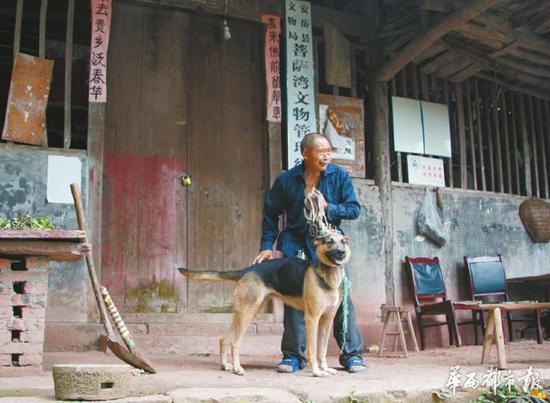
Liao Shunyong, a former office director of the cultural relics bureau, and his wold-dog. (Phot/West China Metropolis Daily)
(ECNS) -- With food expenses of 150 yuan ($22) for one wolf-dog per month, an army of dogs have been cost-effective and reliable protectors of precious cultural relics in southwestern Anyue County for more than a decade, the West China Metropolis Daily reported.
Liao Shunyong, a former office director of the cultural relics bureau, said the county in Sichuan Province started experimenting with dog-assisted security patrols in 2006 and strengthened efforts in 2012 when raids and thefts of cultural relics were rampant.
A Chinese breed similar to the German Shepherd, the dog is known to be intelligent, generally self-assured and able to excel in many tasks after training.
Each cultural relics site at the state level was equipped with two wolf-dogs, with one stationed at provincial, city and county levels, in order to assist security patrols.
Altogether, the county has sent 38 dogs to 31 sites, home to hundreds of thousands of stone sculptures or cliff engravings ranging from the Sui Dynasty (581 -- 618) to the Ming Dynasty (1368 -- 1644). It plans to increase the number of dogs to 66 at 57 sites under cultural protection.
Tang Wenjun, a vice director of the county's cultural relics bureau, said most of the stone sculptures are located in fields and are extremely dispersed, so the county sought the help of dogs.
At the Mingshan Temple, 60 kilometers away from the county's seat, 66-year-old Zeng Xiangyu and a wolf-dog guard cliff engravings that originated in the Song Dynasty.
Zeng said the dog was only 20 centimeters long when it was handed to him in 2006, and now it's about 1.5 meters. He said the wolf-dog is a reliable assistant, and not a single theft has occurred since its arrival.
Tang said that besides Mingshan Temple, other cultural relic sites had reported no raids since the extensive use of wolf-dogs started in 2012. The only side-effect is that the dogs sometimes hurt people and poultry.
The county brings six to seven cubs each year as replacement animals.
Liao Hejun, who works at a provincial-level cultural relics site, said he and his dog needed about 500 yuan for food each month and the rising price of meat has affected his dog's health.
Liao grows vegetables himself and said his dog eats meat only once every three days.
It has been more than 10 years but the monthly subsidy of 150 yuan for the dog's food is far from sufficient nowadays.


















































